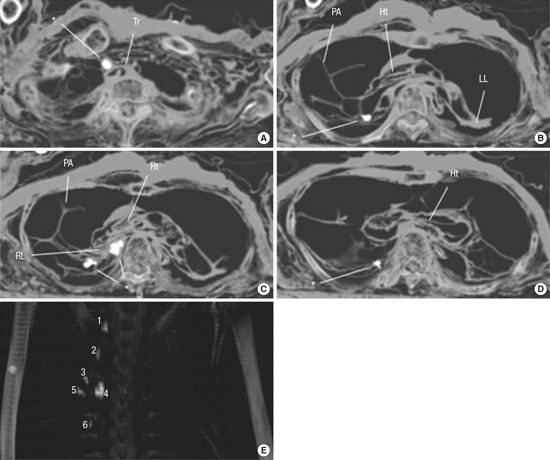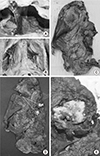1. Masson M, Molnár E, Donoghue HD, Besra GS, Minnikin DE, Wu HH, Lee OY, Bull ID, Pálfi G. Osteological and biomolecular evidence of a 7000-year-old case of hypertrophic pulmonary osteopathy secondary to tuberculosis from neolithic hungary. PLoS One. 2013; 8:e78252.
2. Bos KI, Harkins KM, Herbig A, Coscolla M, Weber N, Comas I, Forrest SA, Bryant JM, Harris SR, Schuenemann VJ, et al. Pre-Columbian mycobacterial genomes reveal seals as a source of New World human tuberculosis. Nature. 2014; 514:494–497.
3. Müller R, Roberts CA, Brown TA. Genotyping of ancient Mycobacterium tuberculosis strains reveals historic genetic diversity. Proc Biol Sci. 2014; 281:20133236.
4. Müller R, Roberts CA, Brown TA. Biomolecular identification of ancient Mycobacterium tuberculosis complex DNA in human remains from Britain and continental Europe. Am J Phys Anthropol. 2014; 153:178–189.
5. Krogman WM, İşcan MY. The human skeleton in forensic medicine. 1986. Springfield, IL: Charles C Thomas Publisher, LTD.
6. Lovejoy CO, Meindl RS, Pryzbeck TR, Mensforth RP. Chronological metamorphosis of the auricular surface of the ilium: a new method for the determination of adult skeletal age at death. Am J Phys Anthropol. 1985; 68:15–28.
7. Lamendin H, Baccino E, Humbert JF, Tavernier JC, Nossintchouk RM, Zerilli A. A simple technique for age estimation in adult corpses: the two criteria dental method. J Forensic Sci. 1992; 37:1373.
8. Gurney JW, Conces DJ. Pulmonary histoplasmosis. Radiology. 1996; 199:297–306.
9. Khan AN, Al-Jahdali HH, Allen CM, Irion KL, Al Ghanem S, Koteyar SS. The calcified lung nodule: What does it mean? Ann Thorac Med. 2010; 5:67.
10. Brown K, Mund DF, Aberle DR, Batra P, Young DA. Intrathoracic calcifications: radiographic features and differential diagnoses. Radiographics. 1994; 14:1247–1261.
11. Urban BA, Fishman EK, Goldman SM, Scott WW Jr, Jones B, Humphrey RL, Hruban RH. CT evaluation of amyloidosis: spectrum of disease. Radiographics. 1993; 13:1295–1308.
12. Palmer PE. Pulmonary tuberculosis--usual and unusual radiographic presentations. Semin Roentgenol. 1979; 14:204–243.
13. Lee KS, Im JG. CT in adults with tuberculosis of the chest: characteristic findings and role in management. AJR Am J Roentgenol. 1995; 164:1361–1367.
14. Bartels P. Tuberkulose (Wirbelkaries) in der jüngeren Steinzeit 1907 (cited by Formicola V et al. Am J Phys Anthropol. 1987; 72:1–6.
15. Formicola V, Milanesi Q, Scarsini C. Evidence of spinal tuberculosis at the beginning of the fourth millennium BC from Arene Candide cave (Liguria, Italy). Am J Phys Anthropol. 1987; 72:1–6.
16. Canci A, Minozzi S, Tarli SM. New evidence of tuberculous spondylitis from Neolithic Liguria (Italy). Int J Osteoarchaeol. 1996; 6:497–501.
17. Roberts CA, Manchester K. The archaeology of disease. 2007. Ithaca, NY: Cornell University Press.
18. Ortner DJ. Identification of pathological conditions in human skeletal remains. 2003. 2nd ed. San Diego, CA: Academic Press.
19. Donoghue HD, Spigelman M, Greenblatt CL, Lev-Maor G, Bar-Gal GK, Matheson C, Vernon K, Nerlich AG, Zink AR. Tuberculosis: from prehistory to Robert Koch, as revealed by ancient DNA. Lancet Infect Dis. 2004; 4:584–592.
20. Suzuki T, Fujita H, Choi JG. Brief communication: new evidence of tuberculosis from prehistoric Korea-Population movement and early evidence of tuberculosis in far East Asia. Am J Phys Anthropol. 2008; 136:357–360.







 PDF
PDF ePub
ePub Citation
Citation Print
Print





 XML Download
XML Download